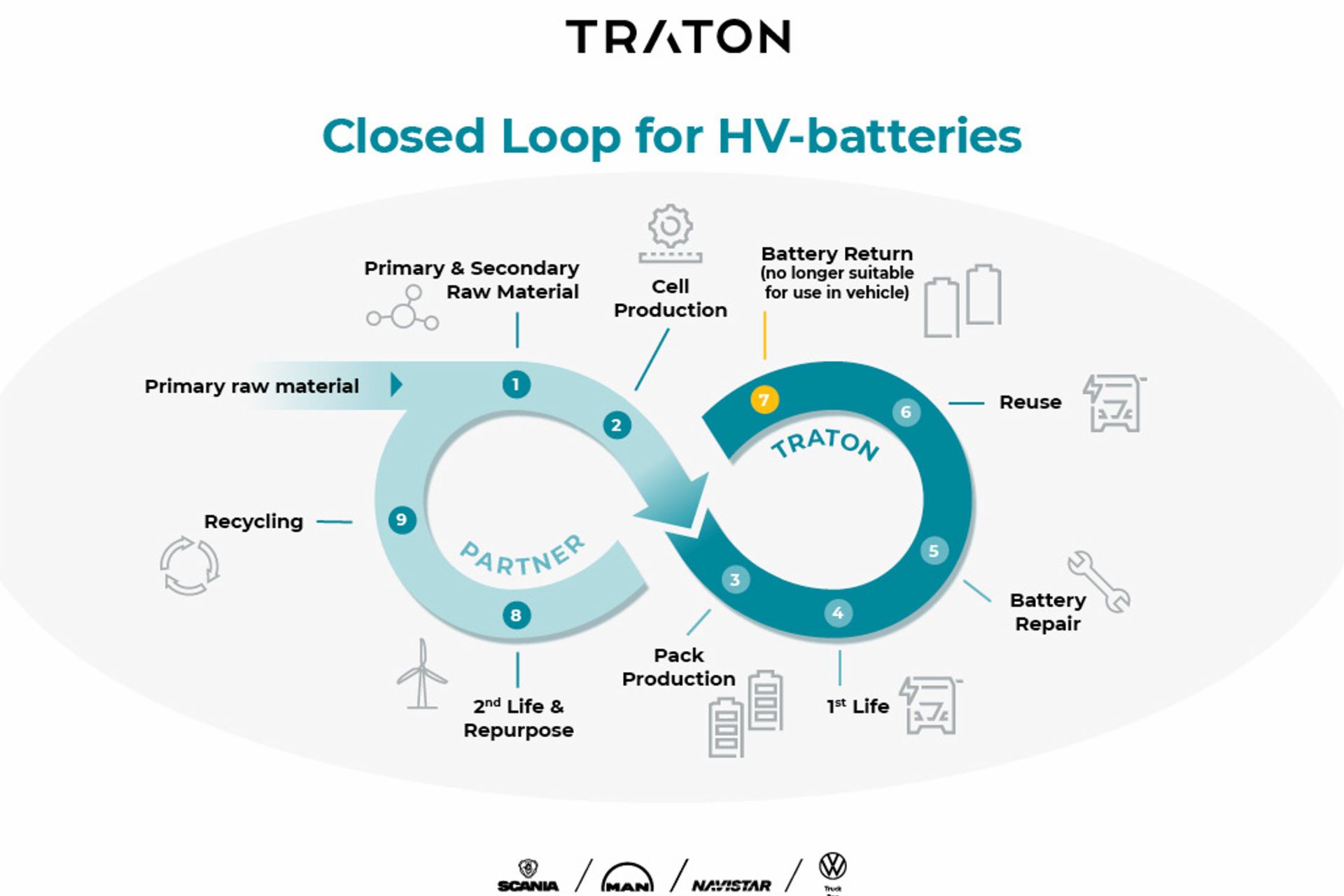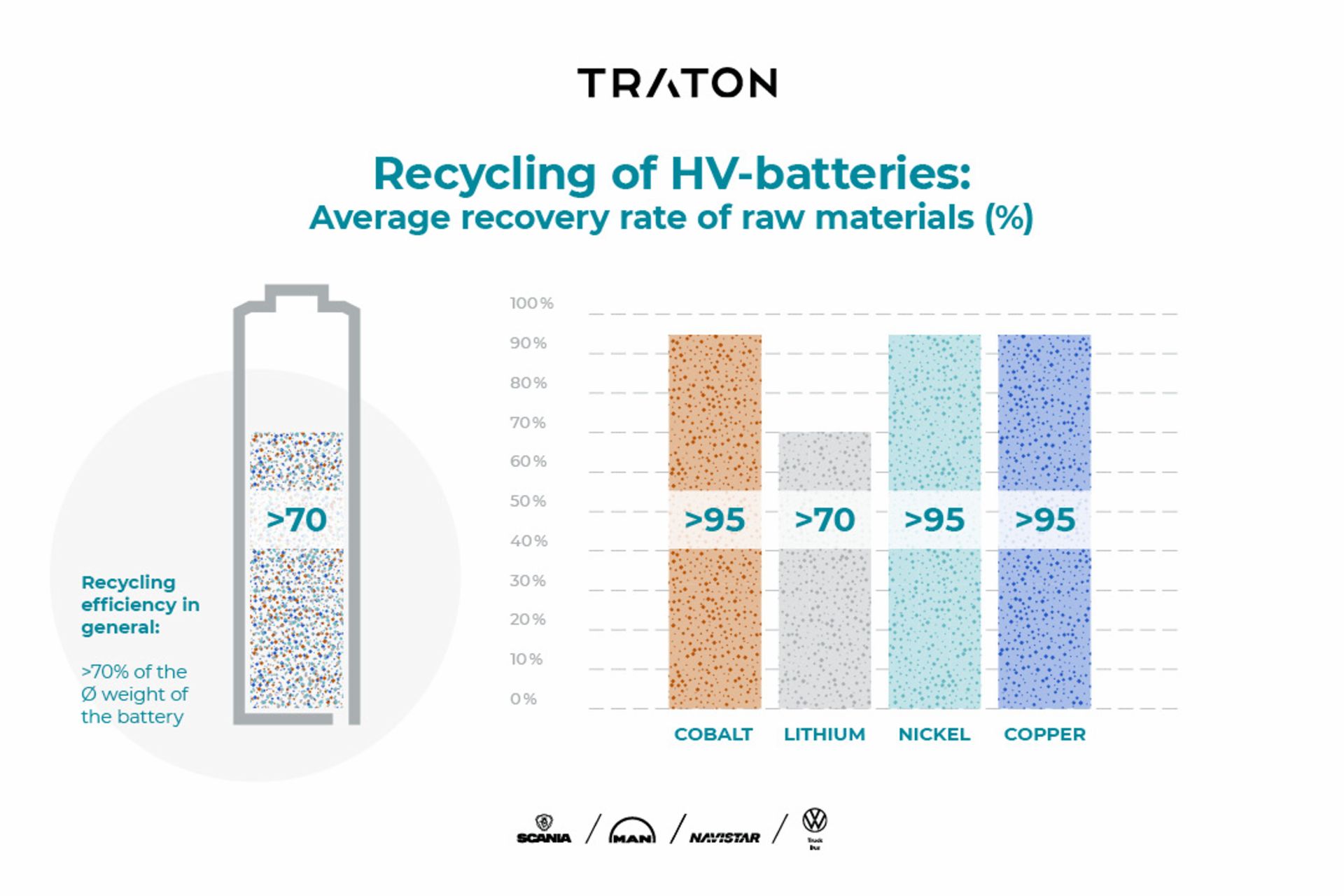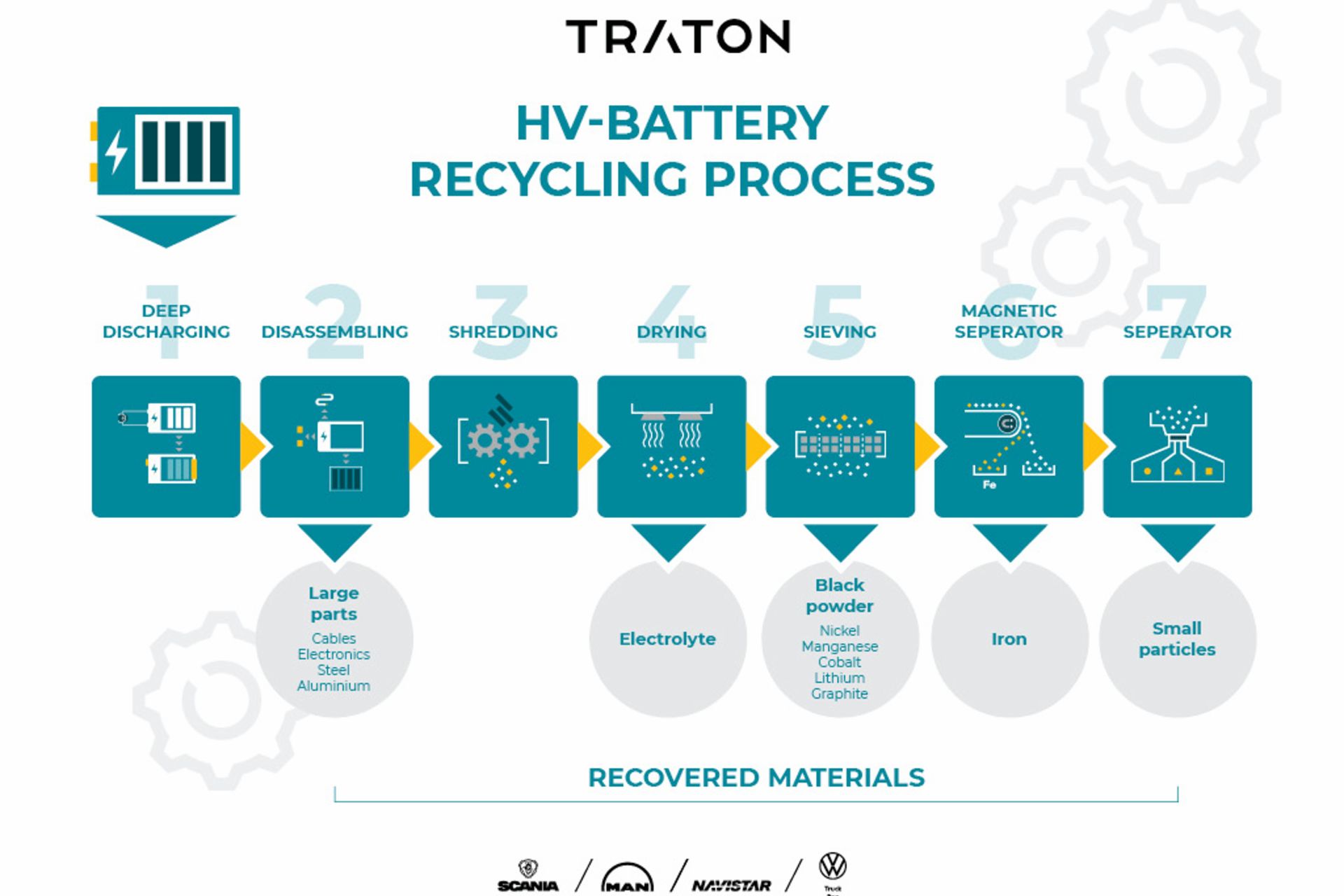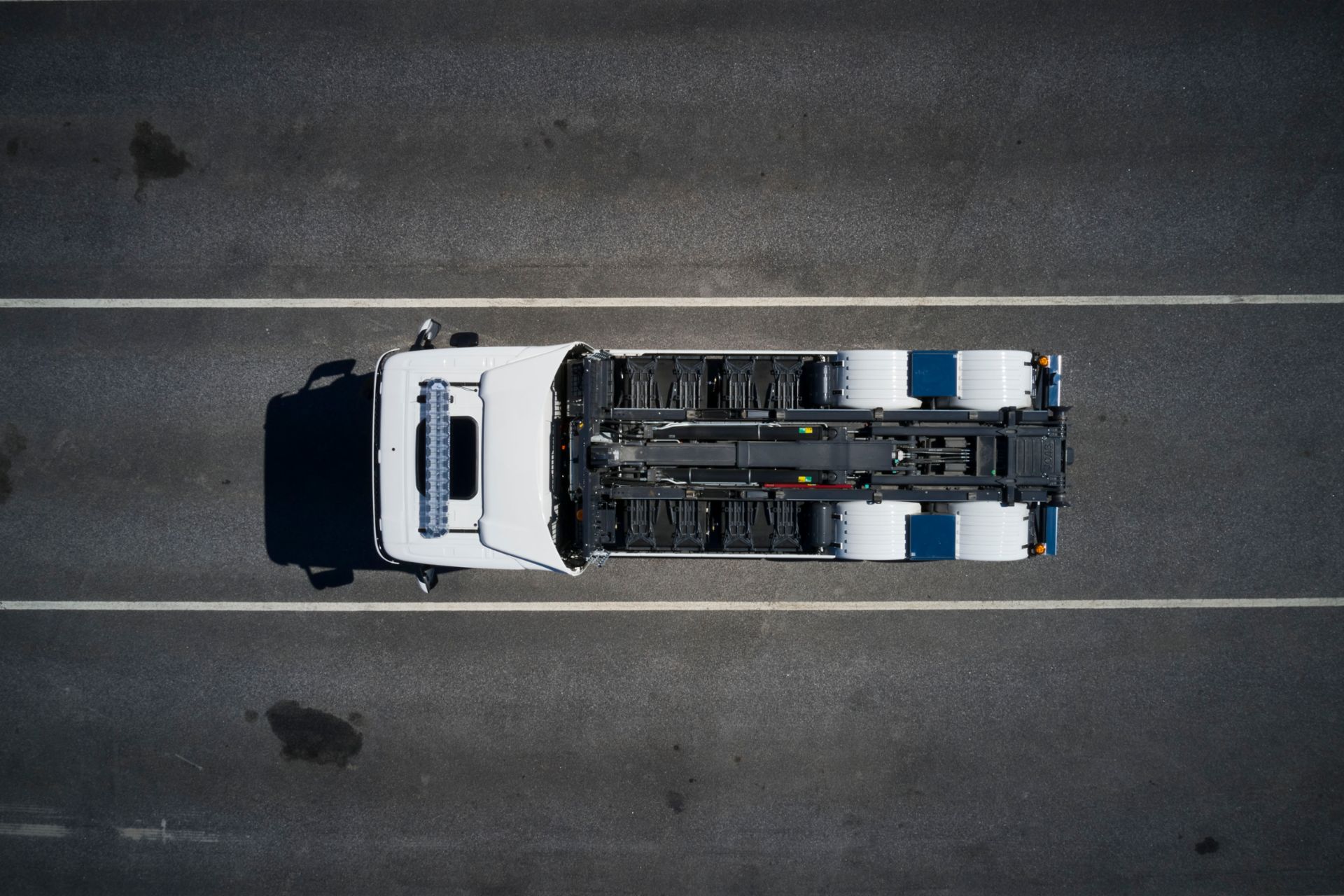Environmental responsibility and new EU battery legislation
The concept of the circular economy has become a central component of sustainable management. This closed-loop approach centers on resource conservation through the prolonged use of raw materials and products before recycling them at the end of their initial life cycle, resulting in a raft of ecological and economic benefits. Today’s high-voltage batteries contain numerous valuable and recyclable raw materials such as cobalt, nickel, lithium, copper, and aluminum that can be re-used and given a second life in other applications.
Sustainable approaches are also being heavily driven by political stakeholders. The EU Battery Regulation Amendment, which came into force on 17 August 2023 as part of the European Green Deal, aims to give electric vehicles an even greater ecological edge over their internal combustion engine counterparts. It also seeks to promote the circular economy by taking a holistic view of the environmental impact of batteries throughout their life cycle. For example, from 2027, manufacturers of batteries and heavy-duty vehicles will be required to recycle 90% of the nickel and cobalt they use, and by 2031, this figure will rise to 95%. This approach also applies to lithium: by 2027, they will be required to recycle 50% of the material used; by 2031 this will rise to 80%.
The life cycle of an e-truck or e-bus battery
If you consider the entire life cycle of a battery, this encompasses its so-called first and second lives, as well as the recycling process. The first life of a battery is defined as its regular usage in a vehicle. Depending on its state of health and how much capacity remains after its initial use, a battery can be repaired and reused again in another vehicle, then it can be repurposed, for example as a battery energy storage system. After this stage, high-voltage batteries are recycled. This holistic approach begins with the first life of the battery – here, batteries are primarily applied in commercial vehicles (for example trucks, buses, or vans). In this phase, commercial operators must take steps to ensure they drive, charge, and use their vehicle in a battery-friendly way. In doing so, the service life of the battery can be significantly prolonged. If the battery pack suffers defects, or if its individual modules no longer function, it can be re-used in the vehicle after being repaired or overhauled at a circularity hub (this is known as ‘second use’). At the end of its service life in the vehicle, the battery can be reconditioned (remanufactured) or re-used in another application to enjoy a so-called ‘second life’. One example of a second life application is a Battery Energy Storage System (BESS), which can provide storage for renewable energies in a fast-charging station, mobile charging or to support the balancing of an electrical grid by compensating for fluctuations due to an oversupply or undersupply of green electricity (peak shaving). After second life use, or if the battery pack or individual modules are not suitable for this, the battery is recycled so that raw materials can be extracted to produce new batteries.
In this context, TRATON gains a competitive edge through its collaboration within the VW Group, where the economical and efficient use of natural resources is a cornerstone of the Group’s overarching sustainability strategy. “The TRATON GROUP and its brands are collectively striving to ensure that the batteries in our commercial vehicles remain in use for as long as possible. After all, every battery that is not produced and installed as a spare part in a bus or truck helps to conserve resources and reduce carbon dioxide emissions,” says Christer Killgren, Business Development Manager for Circular Battery Recycling at Scania. In a cross-functional TRATON team, Killgren works together with MAN’s Business Transformation eMobility HV-Battery Recycling Expert Nicole Rostock on closed-loop concepts for the TRATON GROUP.
“Every battery that is not produced and installed as a spare part in a bus or truck helps to conserve resources and reduce carbon dioxide emissions.”
Christer Killgren, Business Development Manager for Circular Battery Recycling at Scania
Against the background of an increased demand for recycled raw materials (so-called secondary materials) in the future, and sustainability aspects, the importance of circular and recycling strategies will increase,” says Rostock. “Theoretically, a high-voltage battery could achieve 100% recyclability, provided that a customer or market for all recycled products can be guaranteed.”
Killgren adds that second life usage is also becoming increasingly important, for example in the events industry. Last year, the Danish artist Lukas Graham, known for their hit songs ‘7 Years’ and ‘Mama Said’, delivered a virtually climate-neutral performance in front of their fans in Denmark using second life batteries from Scania: “Instead of diesel-generated electricity, the carbon footprint was reduced by 98.5% at these concerts,” says Killgren.
The advantages of the closed-loop battery recycling approach are clear: from a climate protection perspective, re-using an existing truck battery leads to a substantial reduction in carbon footprint over time. Recycling conserves valuable resources while recycled metals have a carbon footprint approximately 25% lower than new metals, as recently reported in the German business newspaper Handelsblatt.
Testing a battery’s health
Before being considered for re-use, batteries must undergo a physical assessment by technicians and engineers to establish their state of health. During these tests, they also evaluate the battery's history and determine whether it still meets the vehicle usage requirements of respective customers. Various factors are assessed for this purpose, including insulation resistance, capacity, temperature, and cell voltage.
Repairing a battery
Before initiating the recycling process, a thorough evaluation of damaged or old batteries is necessary to determine if they can be repaired or replaced. It is estimated that 85% of the batteries delivered to a company contracted by TRATON and its brands can be easily re-used after repair or enjoy a second life. The health status of these batteries collected in the recycling industry is said to be as high as 95%. Every time a battery pack is delivered to a workshop, technicians examine whether the battery pack can be re-used in its entirety. If it cannot, its individual modules are examined. “An intact module can also be used to repair a pack where only a single module is defective, for example,” says Christer Killgren. After secondary use in a heavy-duty vehicle, the second life cycle begins. “This second life cycle can last even longer than the first, because the battery is less stressed due to its prior use. Consequently, it can also offer a lower charge rate,” explains Killgren. The Scania Transport Laboratory in Södertälje, Sweden, demonstrates just how powerful these energy storage systems can be during their second life. Here, 36 battery packs have been combined into a battery storage system that is now used for charging trucks.
Recycling a battery
Battery recycling only hits the agenda after this second life phase, when a vehicle's battery is deemed unsuitable for further use as a storage device or following an accident. “At this point, we aim to recycle the battery’s materials in a closed cycle and raw elements such as nickel, cobalt, or lithium flow into the new production of batteries,” says Nicole Rostock. TRATON and its brands conduct a mechanical recycling process with subsequent hydrometallurgical processing.
In the first stage of the recycling process, a shredder breaks the battery down into its individual parts. Next, plastics and magnetic metals are separated from recyclable materials. “The end product from this process is called ‘black mass’. From this, valuable materials can be extracted during the subsequent chemical hydrometallurgical process,” explains Rostock. Another recycling phase is the so-called pyrometallurgical process. Here, the battery modules are melted down in a blast furnace. The output is a so-called metal alloy, from which the raw materials are extracted in the subsequent hydrometallurgical process. The recyclable materials obtained via this method can then be used to produce new battery cells.
The TRATON GROUP and its brands currently work with six recycling partners in Europe. “One of the major tasks of these recyclers is to enable the safe recovery of lithium while conducting a complex process,” emphasizes Rostock. She is convinced that new technologies will soon be available to support in this regard and that, as a result, this will ensure that the EU’s high lithium recycling quotas can be fulfilled.
There is no doubt that TRATON GROUP supports the circular economy in an environmentally-conscious and economically prudent manner. TRATON and its brands collaborate closely to accomplish this objective through a comprehensive process involving the re-use of old and defective high-voltage batteries for buses, trucks and vans. They also take responsibility for all batteries powering their vehicles beyond their initial life cycle. This is made possible through a series of investments to promote a circular economy centered around BEV batteries, coupled with financial provisions for the future recycling of every e-truck and e-bus battery sold.







